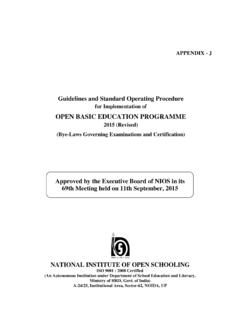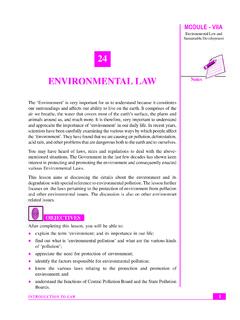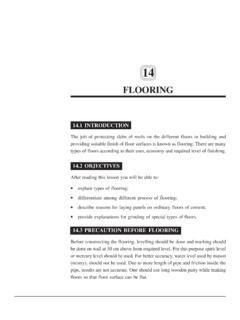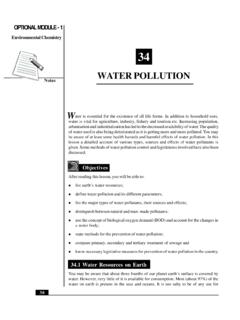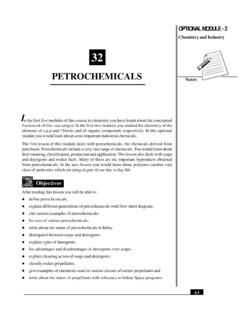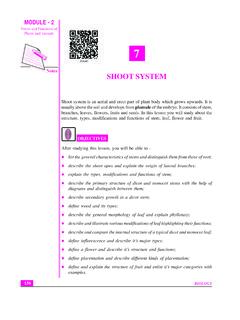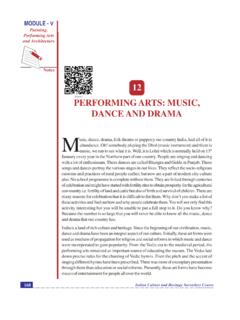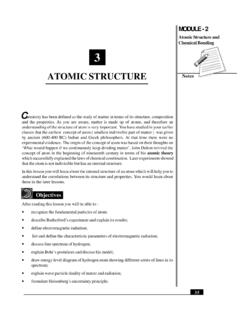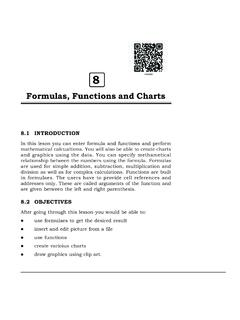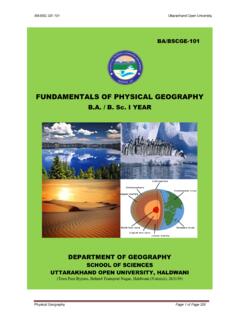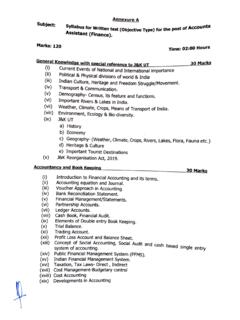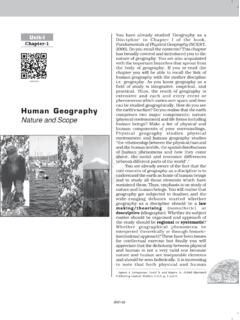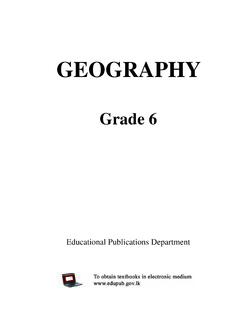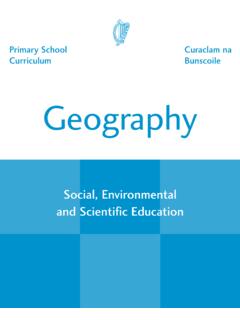Transcription of NA TURE OF GEOGRAPHY AS A DISCIPLINE
1 1 NATURE OF GEOGRAPHY AS ADISCIPLINEThe proposed course aims at explaining the nature of the subject. It throws lighton the importance of GEOGRAPHY and describes the nature of GEOGRAPHY as a attempts to enrich knowledge and illustrate basic concepts as well as technicalterms which are building blocks of geographic knowledge. Effort, however, hasbeen made to develop the concepts in a graded and sequencial manner and deepenthe interest in the is one of the oldest earth science and its roots date back in the worksof the early Greek scholars. The word GEOGRAPHY was first used by the Greekscholar Eratosthenes in the third century Earth and Graphy to describe literal meaning of GEOGRAPHY is to describeabout the earth s surfaces.
2 In other words GEOGRAPHY is largely the study of theinteraction of all physical and human phenomena and landscapes created by suchinteractions. It is about how,why,and where human and natural activities occurand how these activities are has undergone changes in its approach. The earlier geographers weredescriptive geographers. Later, GEOGRAPHY came to be developed as an analyticalscience. Today the DISCIPLINE is not only concerned with descriptions but also withanalysis as well as this lesson you will learn how important GEOGRAPHY is in everyday life. This studywill encourage you to understsnd your own place and spaces with greater studying this lesson, you will be able to: appreciate the use of GEOGRAPHY in daily life; trace development of GEOGRAPHY as a DISCIPLINE ;GEOGRAPHYMODULE - 1 The study of GEOGRAPHY as adisciplineNotes 1 Nature of GEOGRAPHY as a disciplineGEOGRAPHYMODULE - 1 NotesThe study of GEOGRAPHY asa DISCIPLINE 2 Nature of GEOGRAPHY as a DISCIPLINE understand man-environment relationships and their impacts on each other; illustrate the systematic and regional approaches of GEOGRAPHY ; understand various analytical techniques in GEOGRAPHY .
3 Identify the different branches of GEOGRAPHY and its GEOGRAPHY IN DAILY LIFEYou must have noticed that the earth s surface is ever changing; In general, thenatural phenomena like mountains, rivers, lakes etc. change slowly while the culturalelements like buildings, roads, crops, change fast. Travelling from one place toanother you notice that the trees number and types of trees change from area toarea. All this is because of the continuous interaction between the enviroment inwhich we live in and the way we use it. The study of GEOGRAPHY is about observingsuch patterns. Another aspect of GEOGRAPHY is to understand the factors or reasonbehind areal differentiation, how do social, cultural, economic and demographicfactors change our physical landscape and create new or altered landscapes byhuman interventions.
4 For example, human settlements are transformation of forestor barren lands for living purpose by human is often thought of as the art of making and studying maps. Maps giveus a much more correct and graphic view of the way the Earth s surface lookscompared to a picture of drawing. As earlier, even today geographical informationabout an area is available through reports, travel diaries and gazeteers. At presentmaps can be drawn by using satellite images using Geographic Information Systems(GIS) tools. Computers easily convert the information from satelite images intomaps to show what changes development can bring about.
5 Such information is ofbenefit to the society. Such mapmakers are in great demand today. Nowadaysgeographers, engineers, environmental scientists, city planners, social scientists,and many others learn to use GIS to understand the Earth , not only investigtes what is where on the Earth, but also why it isthere. Geographers study the location of the activities, carefully identify patternsusing maps and find out the reasons for these patterns. The areas are then describedbased on the distribution of land forms, population, house type and discover the linkages and movements between places and are able to inferthe spatial processes that are working in an , all over the world there are problems related to providing food security,health, effective energy use and environmental conservation.
6 Equally importantare equality issues and sustainable development. All these can be achieved byusing our resources in sustainable ways. Study of GEOGRAPHY is, therefore, necessaryto learn more about environmental processes and to understand how land useplanning can help us to overcome - 1 The study of GEOGRAPHY as adisciplineNotes 3 Nature of GEOGRAPHY as a disciplineIn is a science of are an essential tool of Geographical Information system is a new tool for making Planning can be done using both maps and the study of geographyBasic ConceptsGeography has been defined differently through different periods of its historyGeographical work in ancient Greece had followed two distinct traditions.
7 Onewas the mathmatical tradition which was focused on fixing the location of placeson the earth s surface, and the other was gathering geographic information throughtravels and field work. According to them, the purpose of GEOGRAPHY was to providea description of the physical features and conditions in different parts of the emergence of regional approach in GEOGRAPHY also emphasied the descriptivecharacter of GEOGRAPHY . According to Humboldt, GEOGRAPHY is the science relatedto nature and it studies and describes all material things found on earth. Anotherimportant school of thought defined GEOGRAPHY as the study of man-environmentrelationships.
8 GEOGRAPHY as a study of the earth s surface. GEOGRAPHY as the study of man-environment QUESTION is GEOGRAPHY is earth s surface changing are the two distinct traditions followed by Greeks (i)_____(ii) DEVELOPMENT OF GEOGRAPHY (A) Ancient PeriodThe earliest records illustrate the interests of scholars in understanding the physicaldomain of the earth by making maps and astronomical measurements. The Greeksare given the credit of being the earliest geographers, prominent among them beingHower, Herodotus, Thales Aristotle and - 1 NotesThe study of GEOGRAPHY asa DISCIPLINE 4 Nature of GEOGRAPHY as a DISCIPLINE (B) Pre-Modern PeriodThis period starting from the middle of 15th century and continuous with 18th earlyprovides us enormous information about the physical and cultural nature of theworld by the travels and explorations of early gergrophers.
9 The early seventeenthcentury witnessed the beginings of a new scientific GEOGRAPHY . ChristopherColumbus and Vasco de gama, Fesdinend Meghellan and Thomas cook wereimportant explorers and travelles among those. Varenius, Kant, Humboldt andRitter led the geographers of this period. They contributed in the development ofcartography and discovering new lands, and developing GEOGRAPHY into a scientificdisciplines.(C) Modern PeriodRitter and Humboldt are frequently referred to us the founders of modern , latter half of nineteenth century is considered as a period of moderngeography. The first modern geographer in true sense was Ratzel who built thestructure of modren GEOGRAPHY on the foundations laid down by classicalgeographers.
10 (D) Recent PeriodThe development of GEOGRAPHY during the post Second World War period hasbeen very rapid. The American and European geographers such as Hartshornehave contributed the maximum during this phase. Harthshorne described geographyas a science dealing with areal differentiation. The present day geographers lookupon regional approach and systematic aproach as complimentary rather thancontradictory. SCOPE OF GEOGRAPHYG eography has now acquired the status of science that explains the arrangementsof various natural and cultural features on the earth is a holisticand interdisciplinary field of study engaged in understanding the changing spatialstructure from past to the future.
